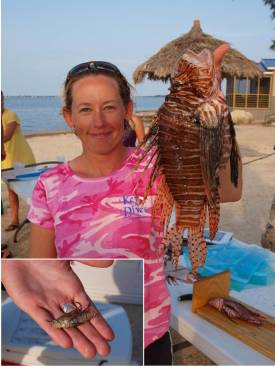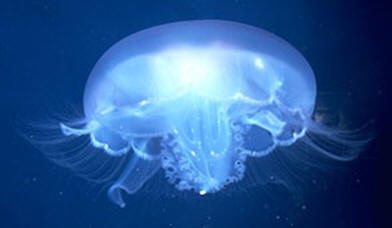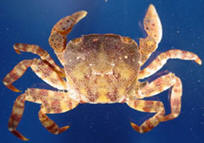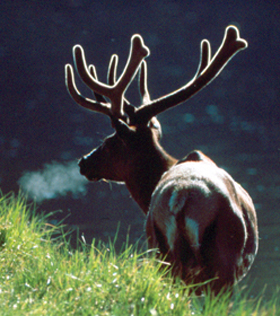Nomenclature

General Information
Length: 15-30 cm
Weight: 2.0 – 2.6 lbs full grown
Color: Red, Maroon, to dark brown with white stripes covering the entire body
Fins: P.miles has 10 dorsal-fin rays and 6 anal-fin rays. Apart from DNA, this is one of the only ways to identify between P.miles and P.volitans. Pterois volitans have 11 dorsal-fin rays and 7 anal-fin rays.
Behavior: Very aggressive, hunt primarily during the night. Usually hide in around rocks or reefs in crevices to avoid detection from predators. When threatened, they spread fins out to appear larger and show off their venomous spines to warn off possible predators.
Common Names:
Devil firefish, Indian turkeyfish, Soldier lionfish, Poisson scorpion, Lionfish
Scientific Name:
Pterois miles (Bennett 1828)
English Literal Translation: Pterois is Greek, which translates to “feathery” in English. This is describing how the fins look when they are fanned out. Miles, from the Latin root, translates to “soldier”. Soldier is describing how the fish is dangerous and armed with venomous spines that it uses to fight. Pterois miles literally means “feathery soldier”.
Scientific Classification:
According to: (Bailly, N. 2013)
Domain: Eukarya
Kingdom: Animalia
Phylum: Chordata
Class: Actinopterygii
Order: Scorpaeniformes
Family: Scorpaenidae
Genus: Pterois
Species: Miles
Domain: Eukarya
Members of the domain Eukarya all have cells that possess a true nucleus, membrane-bound organelles, and most are about ten times larger than prokaryotes. Other species in this group include: Passionfruit, Kiwifruit, Yellow Morel, and the Snowshoe Hare
Kingdom: Animalia
Organisms in the kingdom Animalia are multi cellular, heterotrophic, are capable of motion, capable of reproducing sexually, and their cells do not have cell walls. Other species in this group include: Giant Pacific Octopus, Red Rock Crab, Eastern Grey Squirrel, and Ostrich.
Phylum: Chordata
Members of the Phylum Chordata have a notochord, hollow
nerve cord, gill slits, and a tail that extends beyond its anus. Other
species in this group include:
Bob White Quail,
Mute Swan,
Yellow Perch, and the
Timber Rattlesnake.
Class: Actinopterygii
Actinopterygii are also known as ray-finned fish.
Ray-finned fish have a rigid skeleton, a swim bladder, which helps them
move to deeper or shallow water. A gill cover which enables
them to breath without moving unlike sharks and others who suffocate if
they stay in one place for too long.
Order: Scorpaeniforme
This order contains scorpion fishes, gurnards, and
bullheads. The main characteristics they all share are bony ridges and
spines on their head.
Family: Scorpaenidae
In addition to bony ridges and spines on their head,
they also have spines on their dorsal and anal fins. Most have toxic
glands that it uses to defend against predators. Common names of these fish
are rockfish, scorpionfish, and lionfish, which generally live in
shallow reefs where food is abundant.
Genus: Pterois
More commonly known as Lionfish. Lionfish are a highly
venomous tropical fish with fan shaped fins. They also have tentacles
above their eyes. They are also beautifully decorated with red and white
stripes all along their bodies and fins.
Species: Pterois miles
Pterois miles have fan-like pectoral fins. It also has 13
dorsal spines, 10-11 dorsal-fin rays, 3 anal spines and 6 anal-fin rays.
Adults can get up to a foot and a half. Mostly found in the Indian Ocean and
the Red Sea.
This phylogenic tree is based on mitochondrial and DNA sequences. It shows how closely related Pterois miles and Pterois volitans are to eachother. Also it indicates that Helicolenus hilgendorfit is the furthest relative of the Pterois miles. It also shows that it is closely related to Pterois radiate, Pterois mombasae, Pterois antennata, and Dendrochirus zebra. Original is located at http://bioweb.uwlax.edu/bio203/s2008/ouvrard_mich/classification.html


This phylogenetic tree describes the difference in morphology of the evolution of the jaw closing mechanical advantage. Low advantage means that it has not evolved a more efficient jaw. Intermediate means it has evolved a slightly more efficient jaw. High means it has evolved a very efficient way of opening and closing its jaw to give it an advantage over others who have not. It also shows that even though the Pterois has a similar jaw advantage to Scomber and Sphyraena, it is more closely related to Platichthys and Balistes. This shows an example of convergent evolution between the genus Pterois and the Scomber and Sphyraena.
Original: https://sites.google.com/site/biologybfinalproject/animalia/lionfish-scorpaenidae-pterois
To go to the next page and learn where it lives, click on the Habitat button.








